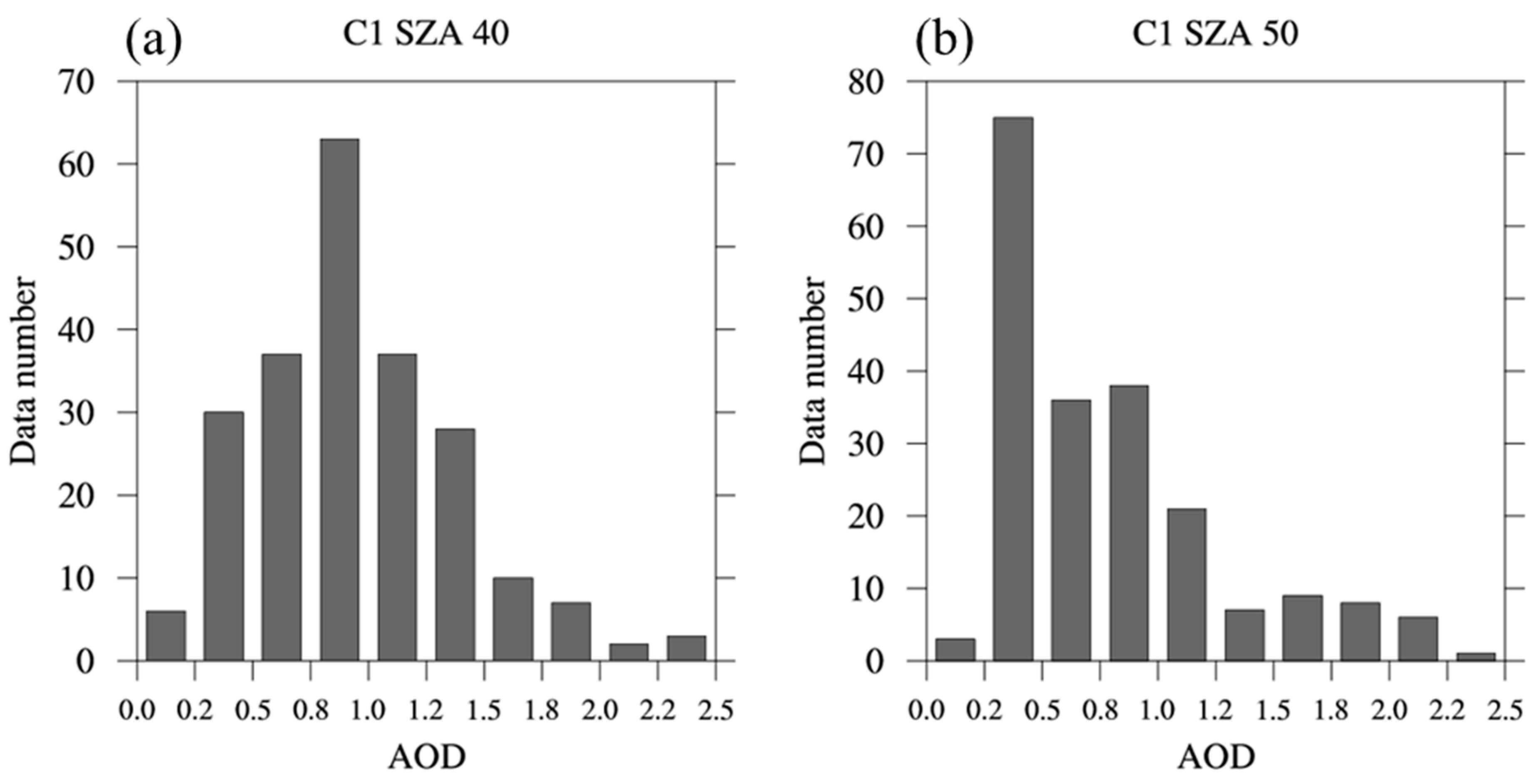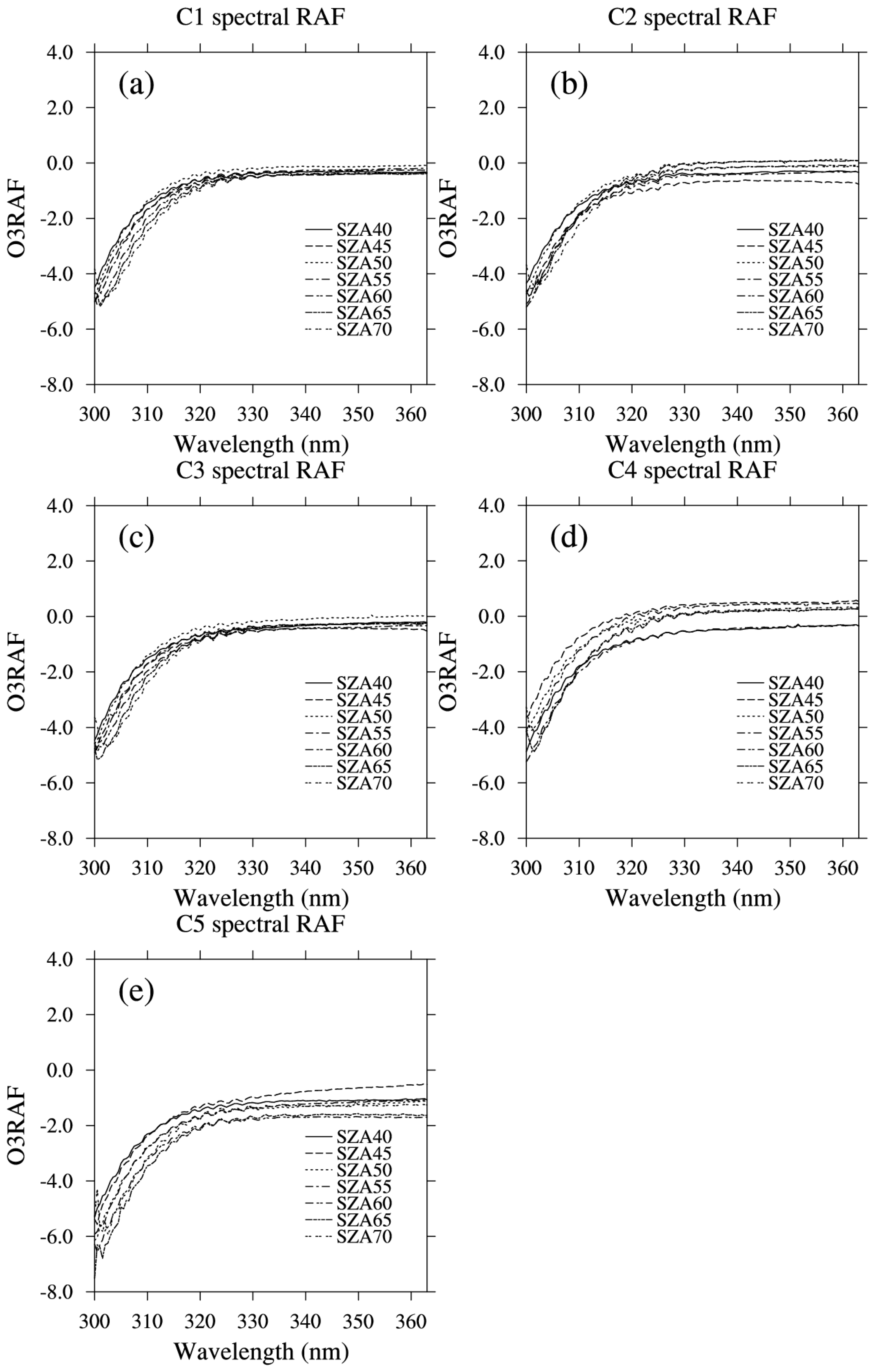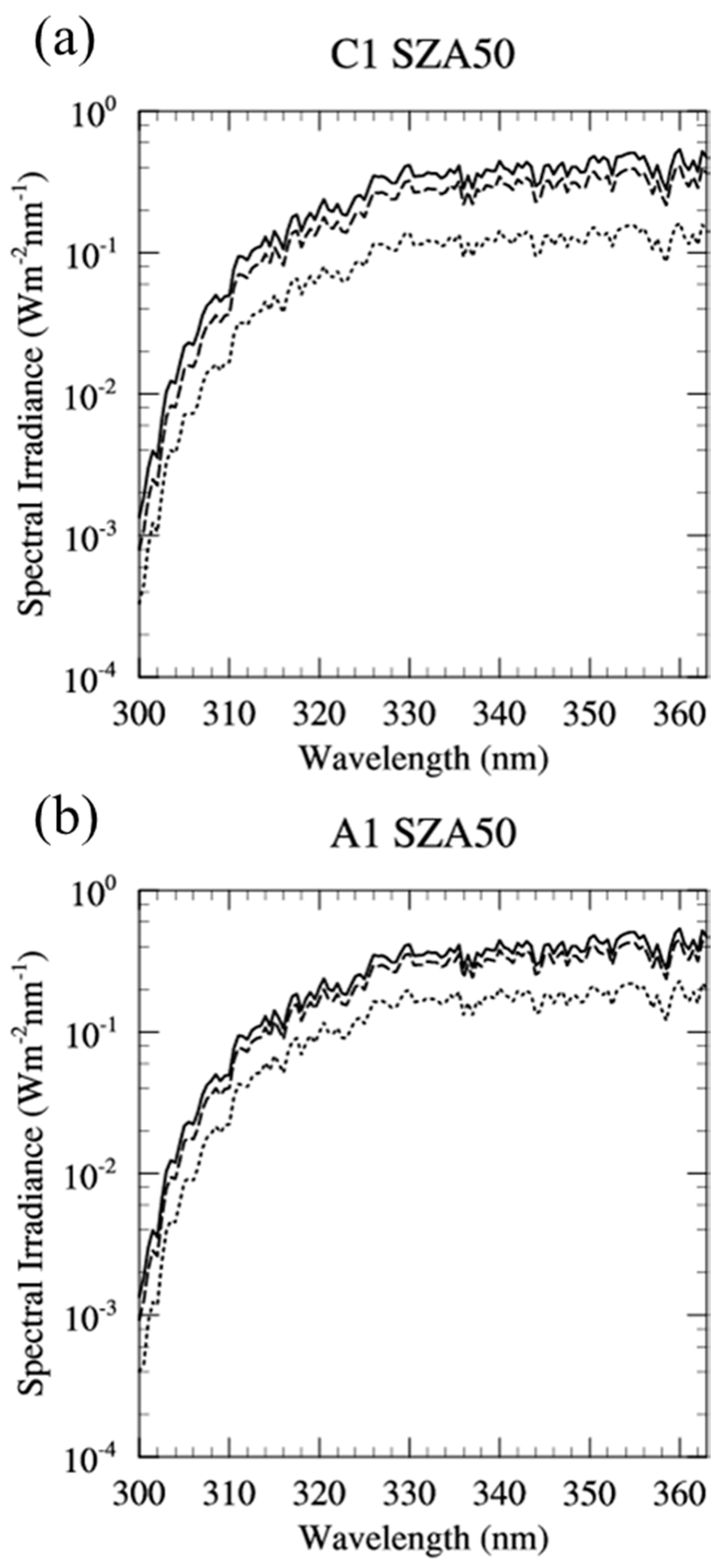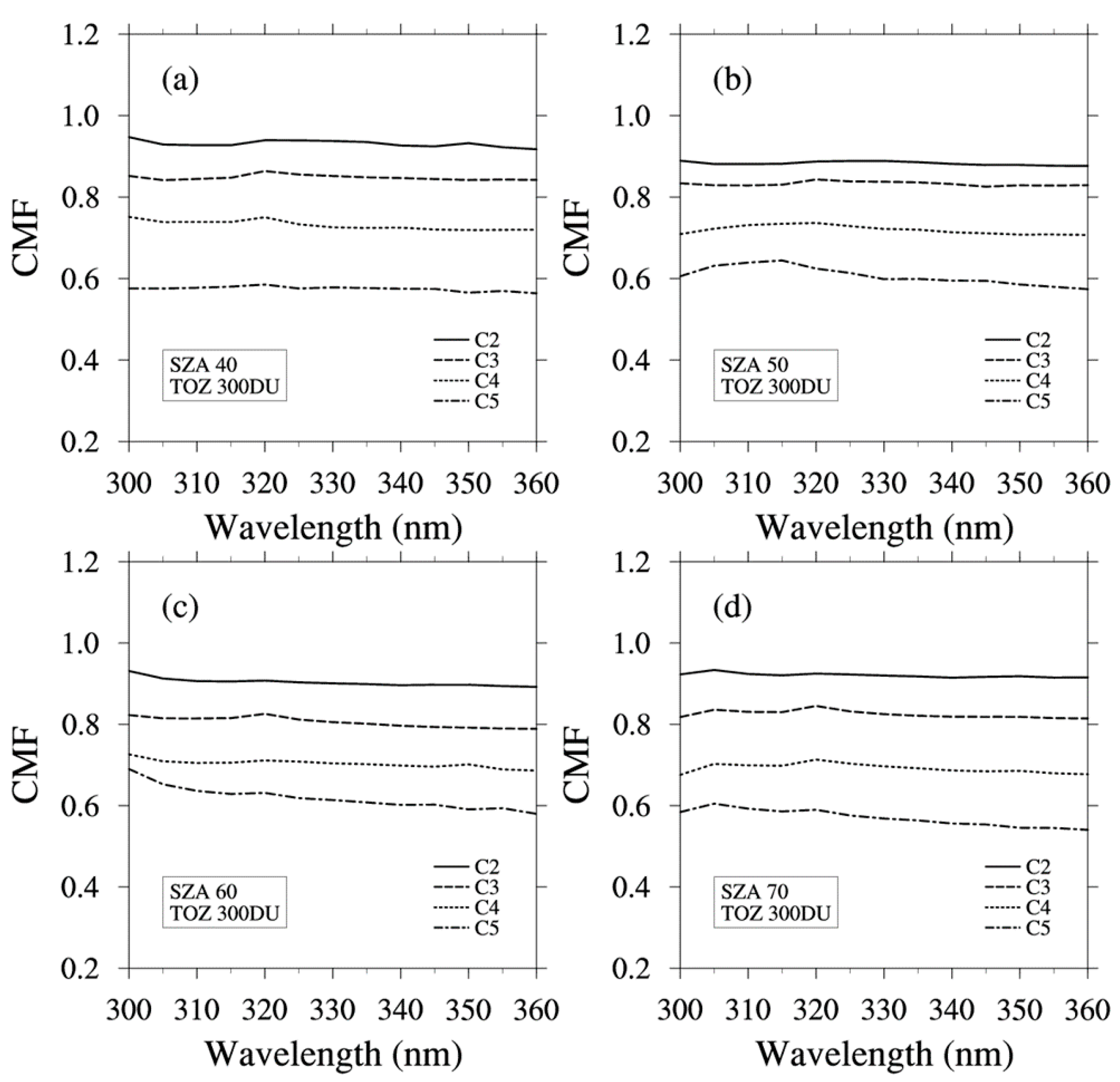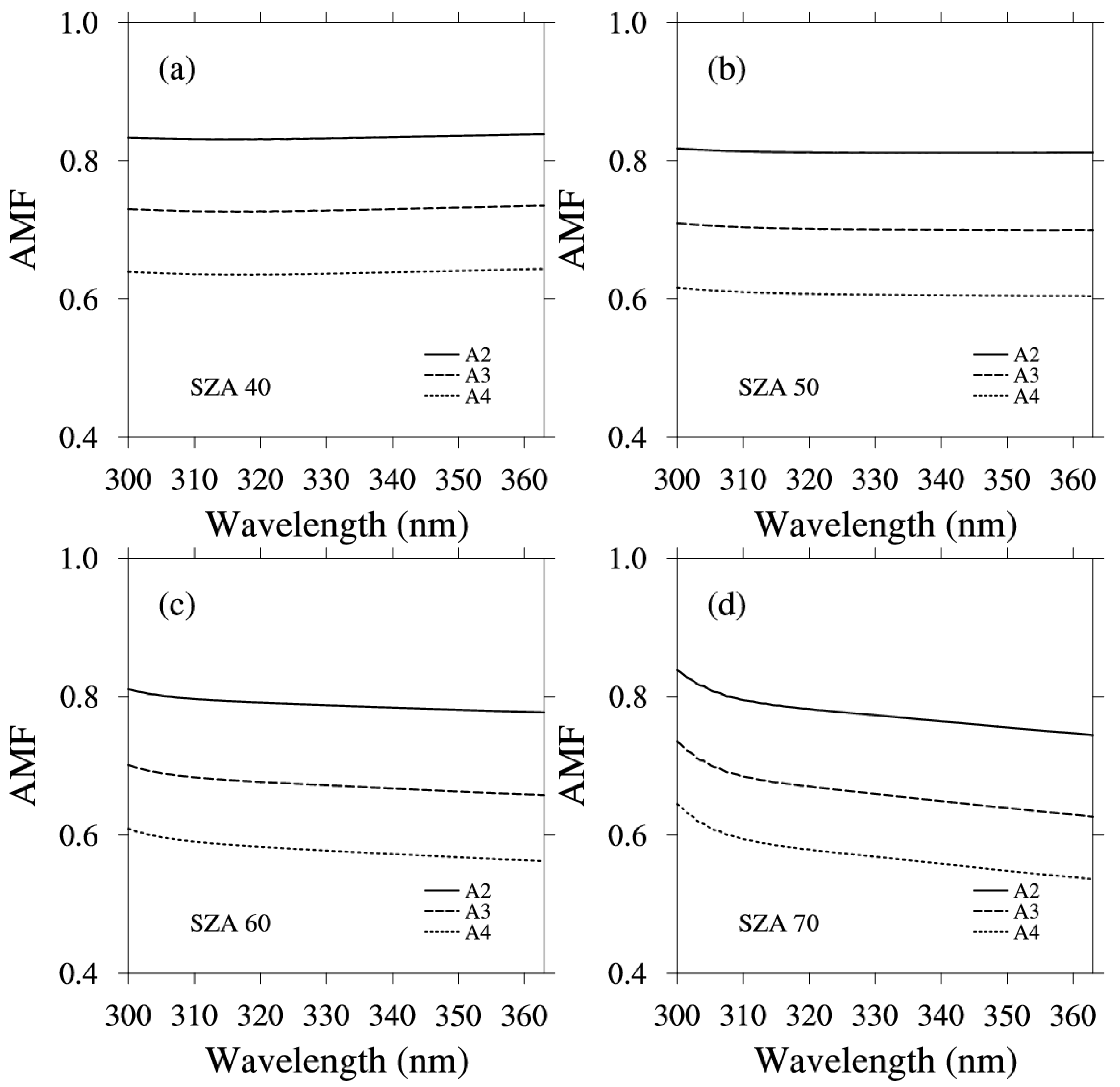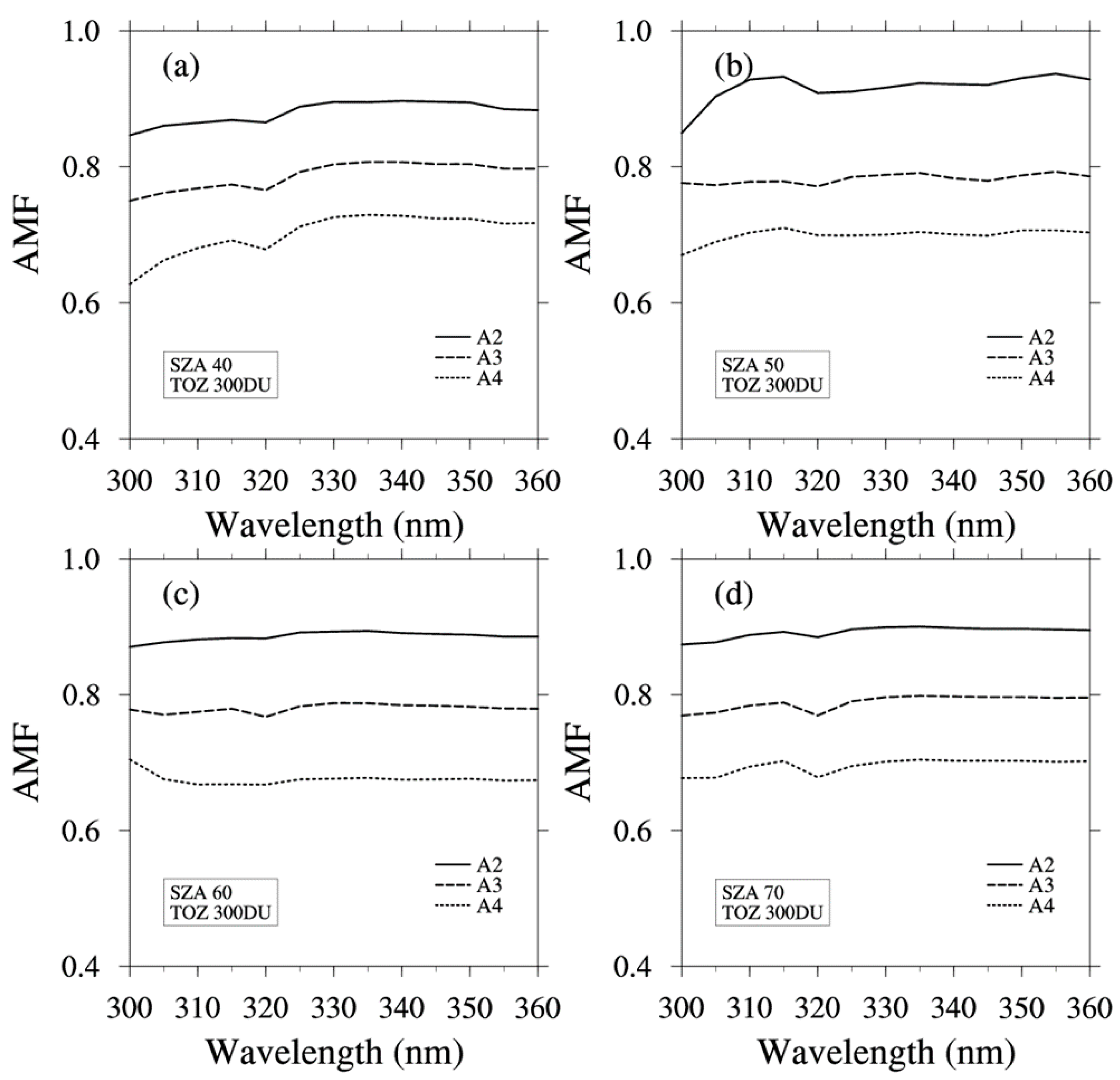3.1. Correction for Ozone Absorption
Before UV radiation is transmitted to the troposphere, and is affected by the strong ozone absorption band. This is the dominant factor in determining UV irradiance at the surface. However, the total ozone amount varies temporally on daily to yearly scales. To correct for the total ozone effect on UV irradiance, the ozone radiation amplification factor (O3RAF) is used, which is defined as the change in UV radiation with total ozone [
20]. Therefore, O3RAF can be expressed as
where F(θ,λ) and dF(θ,λ) are the spectral UV irradiance and its difference between two different conditions of total ozone (Ω) and (Ω + dΩ) in wavelength(λ) and SZA(θ), respectively.
Figure 2 shows the spectral O3RAF under cloud-free conditions from the radiative transfer model (RTM) calculation with respect to SZA. In the O3RAF value with respect to SZA, the irradiance data were considered the surface albedo variation from 0.0 to 0.5.
Figure 3 shows the mean O3RAF from the observational data for the C1–C5 cases. To estimate the theoretical O3RAF, the total ozone is calculated to be the range from 250 to 550 Dobson Unit (DU), which corresponds to a typical annual variation in Seoul [
38,
39], in 10 DU steps. Because of the spectral characteristics of the ozone absorption bands, the O3RAFs from both the RTM simulation and observations converge at 0 for wavelengths longer than 325 nm. In addition, the O3RAF at wavelengths shorter than 325 nm is theoretically estimated to be negative, indicating that the UV irradiance decreases due to increasing total ozone. In the shortwave region, the O3RAF values from both observation and simulation are negative, and they qualitatively converge at around 0 in the long-wave region. Because of the long optical path length caused by an increasing SZA, the O3RAF increases with SZA. For SZA between 40° and 70°, the O3RAF is amplified by more than 1.5 times in the spectral range of ozone absorption. Furthermore, the O3RAF decreases sharply with increasing wavelength due to the spectral characteristics of the ozone absorption band.
A quantitative bias of the O3RAF between the model and observations is found, although the shapes of the spectral variations are similar between the model and observations. The O3RAF from the RTM under clear-sky conditions sharply converges to 0.0 in the long wavelength range for all surface albedo and SZA conditions (
Figure 2). However, the O3RAFs from the observations vary considerably with changing cloud and SZA conditions. The discrepancies of O3RAF at wavelengths longer than 330 nm range from −1.0 to 1.0, and the intensity of the discrepancies is amplified as the cloud conditions change. Because observation data use a loose threshold in order to ensure the number of observations for clear-sky conditions, the O3RAF error arose under a range of conditions during the long-term observations. Changes in observational conditions also affect the O3RAF in the spectral range of ozone absorption. Therefore, the O3RAF based on observation potentially includes the effects of both ozone absorption and variations in observation conditions. In addition, it is difficult to correct for spectral irradiance in the case of O3RAF based on observations.
The interactions between ozone and tropospheric scattering materials are thought to have a negligible effect on radiation, because most of the total ozone is distributed in the stratosphere, while scattering by clouds and aerosols occurs mostly in the lower troposphere. Therefore, a model-based value can be used for the reference O3RAF under clear-sky conditions (i.e., aerosol- and cloud-free conditions). Based on the O3RAF, the UV irradiance is spectrally corrected to the reference total ozone amount condition, 300 DU.
Figure 4 shows the spectral UV irradiance after correction of the total ozone amount for the C1 and A1 cases. After correction of the total ozone amount using O3RAF, the observed UV irradiance convergence is improved, especially at wavelengths shorter than 330 nm. Thus, by correcting the total ozone amount we can estimate the CMF and AMF accurately.
3.2. CMF
Figure 5 shows an example result of the spectral CMF from the RTM simulations at SZA of 40°, 50°, 60°, and 70°. Because the RTM assumes a homogeneous cloud-covered sky owing to the 1-dimensional assumption, all CMFs explain the attenuation under overcast conditions. For this reason, the theoretical CMF can be used to identify differences in observational CMF by changing the cloud thickness. The largest decreases in CMF due to the COD change are seen for a COD of 5, and the smallest for a COD of 20. In addition, the CMF value decreases at longer wavelengths for all SZA and COD conditions. In
Figure 5, the difference in CMF between 300 and 360 nm is about 0.05.
Table 3 shows the spectral CMF for COD values of 5, 10, 15, and 20. The spectral mean value of CMF from 300 to 360 nm at SZA of 40° is 0.80, 0.66, 0.57 and 0.50 for COD of 5, 10, 15 and 20, respectively. When the COD increases by 5, the decrease in CMF is 0.14 and 0.07 for COD of 10 and 20, respectively.
The CMF sensitivity to SZA gradually decreases with increasing SZA (
Table 3). By increasing SZA in 10° increments at COD of 10, the spectrally averaged CMFs change by 0.020 at 40°, 0.019 at 50°, and 0.010 at 60° of SZA. In addition, the decrease in CMF due to SZA increases shows the spectral dependence. Previous study [
30] showed that the reduction rates of broadband correction factors are insensitive for SZA change at large SZAs because of weak direct radiation intensity. Because the extinction intensity for direct radiation is affected by the spectral dependence of Rayleigh scattering, decreasing rates of CMF with SZA are larger at longer wavelengths. When the SZA changes from 40° to 50°, the decrease in the CMF is 0.003, 0.018, 0.024, and 0.028 at 300, 320, 340, and 360 nm, respectively. The optical depth due to Rayleigh scattering rapidly decreases with increasing wavelength, and the effects of cloud extinction are relatively important for determining irradiance at the surface.
Overall, the CMF has spectral sensitivities for all COD cases.
Table 4 shows the spectral dependence of the CMFs, defined as the difference in CMF within the spectral range of 300 to 360 nm. Differences in CMF range from 0.032 to 0.044 for SZA of 40°, and 0.050 to 0.054 for SZA of 60°. The spectral sensitivity of the CMF is twice as large as the SZA sensitivity (compare
Table 3 and
Table 4). In addition, the theoretical CMFs have a peak in their spectral sensitivities at around 310 nm, which shifts to shorter wavelengths with increasing SZA. In addition, this peak point in spectral sensitivity shifts to shorter wavelengths with decreasing COD. Because Rayleigh scattering depends strongly on wavelength, the spectral decrease in CMF is intensified as optical path length increases. At shorter wavelengths, the CMF increases with increasing wavelength because of weak direct radiation and enhanced diffuse radiation [
30].
In the theoretical estimation of the CMF, the spectral dependence of the CMF is a result of scattering by clouds and extinction after cloud scattering. In the real atmosphere, the CMF will also be affected by variations in cloud type, thickness, and discontinuities.
Figure 6 shows the spectral CMF with respect to SZA and cloudiness within the spectral coverage of the Brewer spectrophotometer from long-term observations. To minimize the effect of variations in instrument conditions, the CMF value is smoothed to a 5 nm resolution. With increasing cloudiness, the CMF tends to decrease for most wavelengths and SZAs. For SZAs of 40°–60°, the CMFs from 300 to 360 nm were 0.88–0.95 and 0.56–0.69 for cloudiness categories C2 and C5, respectively. All of the CMFs indicate that increasing cloud cover significantly attenuates the UV irradiance for all wavelengths and geometries. Overall, the CMF difference between C2 and C5 ranges from 26% to 41%. Furthermore, the CMF shows significant spectral dependence (
Table 5). All of the cloud categories show a spectral dependence for the CMF. The spectral dependence of the CMF from 300 to 360 nm is 2.5%, 3.3%, 4.6%, and 10.0% for C2, C3, C4, and C5, respectively. Qualitatively, the spectral dependence of the CMF is related to the spectral difference in the ratio of scattering intensities between clouds and air molecules. Because the spectral dependence of the COD is less than the Rayleigh scattering, the extinction effect due to the presences of clouds is more important at longer wavelengths.
The CMF from 320 to 360 nm decreases slightly as wavelength increases, except for C2 with a SZA of 70°. The spectral CMF from the observations is similar to that from the simulation, which is based on the COD change. However the spectral CMF values and the decreasing CMF per unit wavelength are complicated within the spectral range of 300 to 320 nm. In this spectral range, the ozone absorption effect is the dominant factor in UV irradiance change. In this study, the spectral irradiance data are corrected for variation in ozone absorption by adopting the O3RAF and total ozone amount. However, there are errors associated with the measured total ozone from the Brewer spectrophotometer. The total ozone between the Brewer spectrophotometer and the Dobson spectrophotometer varied by about 5% (one standard deviation) with a 1% bias for all measurement datasets in Seoul [
38]. In addition, the ZS measurement, which is the main observation method under cloudy conditions, is based on a regression equation calculated using the most recently measured DS observation under clear-sky conditions. Therefore, the total ozone from the ZS measurement varies significantly with cloud conditions due to changes in scattering. As seen in
Figure 2, the O3RAF is estimated up to −6.0, which indicates that the total ozone error of 1% will lead to a CMF error of up to 0.06.
3.3. AMF
Figure 7 shows the spectral AMF with respect to AOD based on the theoretical calculation in AOD for 0.5 < AOD < 1.0 (A2), 1.0 < AOD < 1.5 (A3), and 1.5 < AOD < 2.0 (A4). When compared with the irradiance when AOD = 0.0, the AMF ranges from 0.777 to 0.866 for the A2 cases after averaging over changes in surface albedo, but the AMF decreases to 0.572–0.695 for A4, for SZA of 0°–80°.
Table 6 lists the spectral AMF in AOD for A2, A3, and A4 with mean AMF and its standard deviation in AOD categories. The standard deviation is estimated by the variation of all simulated AMF value for AOD in AOD categories. Spectral mean values (standard deviations) of AMF from 300 to 360 nm at SZA of 40° are 0.833 (0.063), 0.729 (0.054), and 0.638 (0.047) in AOD category for A2, A3, and A4, respectively. When the AOD increases by 0.5 at SZA = 40°, the decrease in AMF is 0.104 and 0.091 from A2 to A3 and from A3 to A4, respectively.
The maximum and minimum AMF are summarized in
Table 7 with respect to the SZA and AOD categories. The spectral dependence of the AMF is lower than that of the CMF. The AMF varies from 0.007 to 0.045 over the wavelength range in all simulation cases. Although qualitative optical characteristics of aerosol are similar to those of cloud, which have large forward scattering with small spectral dependence of optical depth, dynamic range of AOD is 10 times lower than the range of COD. For this reason, the spectral difference of the AMF is smaller than that of the CMF at the same SZA. In addition, the spectral difference of the AMF is amplified in large SZA, especially when the SZA is larger than 60°. At a SZA of 60°, the AMF difference is 4–5 times larger than for a SZA of 50°. The strong spectral contrast at large SZA is similar to that seen in CMF (
Table 4). Because of the large optical path length at large SZA, the penetration depth of photons is sensitive to the wavelength change. Therefore, the AMF and CMF increase as the wavelength is reduced. In addition, the sensitivity of the spectral difference of the AMF to SZA is larger than that for the CMF, strong penetration depth effect in AMF, because the aerosol layer is assumed to be lower than the cloud layer in the RTM simulation.
The AMF based on observations is presented in
Figure 8, and AMF values are listed in
Table 8. The decrease in the AMF with AOD, for SZA = 40°, is 0.09–0.10 from A2 to A3 and 0.07–0.12 from A3 to A4, similar to the theoretical AMF decreases. However, the decrease in the AMF by SZA is insignificant in all AOD categories. Similarly, the AMF shows insignificant changes over the UV spectral range, which includes variations in the AMF without a consistent spectral trend. In the CMF calculation, the spectral difference is clearly seen except in the ozone absorption range of 300–320 nm due to errors in the total ozone measurements from the Brewer spectrophotometer. Furthermore, complicated features of the spectral AMF are found in
Figure 8 due to problems relating to the clear-sky assumption. The AMF from observations assumed that aerosol-free conditions have AOD < 0.5 (A1 hereafter) in order to ensure a sufficient number of observations in the calculation. From the simulation study, the AMFs for AOD < 0.5 range from 0.88 to 0.97, with dependencies on wavelength and geometry. In particular, A1 with SZA of 40° and 50° have only 35 and 71 data points, respectively, which is only around one observation per month. Therefore, referenced irradiance spectra are perturbed for SZAs of 40° and 50°, and this affects the spectral discrepancies (i.e., local maxima or minima) in the outside of spectral range of total ozone absorption. In summary, the spectral difference in AMF from observations is insignificant due to variations in the clear-sky irradiance spectrum related to the limited amount of data, in addition to the total ozone error, although the AMF shows weak spectral dependence from the RTM simulation.
